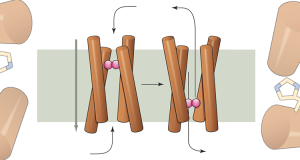In this podcast, Michael Grabe from the University of California – San Francisco describes how scientists designed completely from scratch a protein molecule that behaves like a slice of life.
The synthetic mimics a natural protein found in living cells that transports ions across a cell membrane. The cell membrane surrounds living cells like an envelope. And ion transport through the membrane helps keep us alive. It lets nutrients in and waste out of cells, and it also transmits signals between nerve cells of the brain and spinal cord.
Scientists used the Stampede supercomputer at TACC to model the stability and dynamics of the designed protein. They did this with an allocation through XSEDE, the Extreme Science and Engineering Discovery Environment, funded by the National Science Foundation. The researchers published their results in the journal Science in December 2014.
Read the Full Story at TACC * Sign up for our insideHPC Newsletter.





